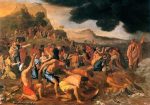“The Crossing of the Red Sea,” a painting by Nicolas Poussin, which was commissioned in 1632. It can be found at the National Gallery of Victoria in Melbourne, Australia. (photo by Nicholas Poussin via Wikimedia Commons)
The Israelites left Egypt on the first day of Passover, but the Egyptians didn’t leave them until the sea separated them forever on the seventh day. By celebrating Passover for seven days, we celebrate ambivalent feelings of joy and stress. Shabbat Shira – the Shabbat whose Torah portion contains the song sung by Israel after the splitting of the Red Sea – invites us to focus on the miracle of Passover’s seventh day.
Just imagine the unbearable stress when Israel was caught in a death trap between the Egyptians and the sea, the shouts, cries and prayers. Imagine the hand of Moses raised, the long and dark night between the protecting pillar of fire and the cloud, the great wind splitting the sea in two, the first steps into the water, crossing on dry land, seeing the vicious enemy destroyed.
It is not surprising that it resulted in an epic song. While evil was drowned in deep water, happiness flooded Israel. Only a heartless man wouldn’t sing. How many of us are capable of imagining this and meaning what they say in Exodus (15:1-2): “Sing to God…. This is my God, and I will glorify Him.” What a great national miracle that was, once upon a time.
Is this episode still relevant for us today? When we think of the Sinai revelation, it’s clear – we have the Torah. But is something left from the Song at the Sea? If the answer is yes, what is the key for finding meaning?
Our sages interpreted the future tense of the song as indicating a song that hasn’t yet been sung. Thus, for example, they say, “It is not written, ‘then Moshe sang,’ but ‘will sing.’” The sages also attributed a double reading to the words “Elohai avi” – they read it as both, “the God of my fathers,” and “God is my father.” They elaborated on the significance of the song to “every single generation.”
Indeed, the secret for singing a song of faith lays in this verse. My teacher, Rabbi Prof. David Hartman, used to point out that the coin has two sides. Many can tell about our own God; many can tell stories about the God of our fathers. The secret of the Jewish people lays in the way we identify our own God with the God of our fathers.
My grandmother, Savta Privah, sang her personal song at the sea more than 70 years ago, when she was liberated from Auschwitz. On her way from the refugee camps to Israel, she told my grandfather, “Now that we are making aliyah to Israel, from now on, we are Zionists.”
Going down from the ship, my grandfather, Saba Menachem, was asked for his occupation. He had lost his parents at a young age and had worked for his living even before the Holocaust.
“I’m a tinsmith,” he said.
Very well, they said, register with the labour union and we will find you a job.
“I had enough red flags in Europe,” my grandfather said, and established his own business.
Ironically, he found work at Mishmar Ha’Emek, one of the most anti-traditional Israeli kibbutzim. He was the only observant employee. Back then, they had two dining rooms, one for the young kibbutznikim and another one for the elders, because only they kept kosher.
My grandfather – a young man at that time – used to eat with the elders. One day, Shoshana Hazan, mother of Yaakov Hazan, leader of the Shomer Hatza’ir youth movement, came to his table with two Shabbat candlesticks.
“These are our family silver Shabbat candlesticks,” she said, “but my daughter-in-law would never use them. Take them to your wife to light Shabbat candles.”
Read more at jns.org.
Dr. Shraga Bar-On is a member of the Beit Midrash for New Israeli Rabbis Program of the Shalom Hartman Institute and HaMidrasha at Oranim.

